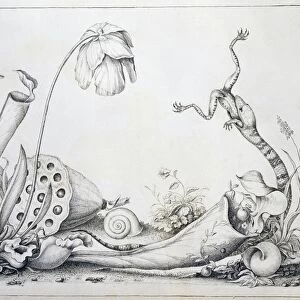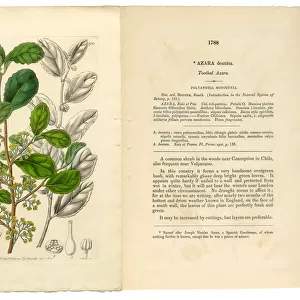Sarracenia flava, yellow pitcher plant & Sarracenia purpurea
![]()

Wall Art and Photo Gifts from Mary Evans Picture Library
Sarracenia flava, yellow pitcher plant & Sarracenia purpurea
Nelumbo lutea, American lotus & Triodopsis albolabris, land snail & Cemophora coccinea, scarlet snake. Drawing 30 (Ewan 22) from the Botanical and zoological drawings (1756-1788) by William Bartram
Mary Evans Picture Library makes available wonderful images created for people to enjoy over the centuries
Media ID 8620469
© Mary Evans Picture Library 2015 - https://copyrighthub.org/s0/hub1/creation/maryevans/MaryEvansPictureID/10708835
18th Century Alecto Asterid Bartram Botanical Illustration Caenophidia Colubrid Colubridae Common Diapsid Diapsida Eating Ericales Eudicot Eudicotinae Eurosid Fabaceae Fabales Fabidae Feeding Angiospermae Dicot Dicotyledon
EDITORS COMMENTS
This 18th century drawing, titled "Drawing 30" from the Botanical and Zoological Drawings by William Bartram (1739-1823), showcases a vibrant and intriguing assemblage of American flora and fauna. At the center of the composition, two pitcher plants, Sarracenia flava (yellow trumpet pitcher) and Sarracenia purpurea (purple pitcher), are depicted in their natural habitat. These fascinating plants, native to wetlands along the eastern coast of North America, are known for their unique, funnel-shaped leaves that trap and digest insects for nutrients. Surrounding the pitcher plants, a variety of native species can be observed. In the foreground, an American lotus, Nelumbo lutea, floats gracefully on the water's surface with its large, circular leaves and distinctive yellow flowers. A land snail, Triodopsis albolabris, can be seen climbing the stem of the lotus, while a scarlet snake, Cemophora coccinea, slithers along the edge of the pitcher, poised to strike a potential meal. Bartram's meticulous attention to detail is evident in the intricate illustration of each species, revealing the complex relationships between these organisms in the natural world. The botanical illustration showcases the common names and scientific classifications of each organism, including their respective taxonomic groups: Fabaceae for the Fabaceae family of the Fabales order, Eudicot for the Eudicot division, Angiospermae for the Angiosperms, and Ericales for the order of the pitcher plants. The colubrid snake is classified under the Colubridae family, the Dicotyledon class, the Asterid clade, and the Eudicotinae subclass. This drawing is a testament to Bartram's extraordinary ability to observe and document the natural world, providing a valuable record of the biodiversity of the American continent during the 18th century.
MADE IN THE USA
Safe Shipping with 30 Day Money Back Guarantee
FREE PERSONALISATION*
We are proud to offer a range of customisation features including Personalised Captions, Color Filters and Picture Zoom Tools
SECURE PAYMENTS
We happily accept a wide range of payment options so you can pay for the things you need in the way that is most convenient for you
* Options may vary by product and licensing agreement. Zoomed Pictures can be adjusted in the Cart.



